Manuscripts Etc.
| CLOSE WINDOW |

|
The following items are drawn from the William Faulkner Foundation Collection at the University of Virginia's Albert and Shirley Small Special Collections Library (http://small.library.virginia.edu/). |
|
Judging by the number of times he wrote and revised it, the story about the auction of the Texas horses in Frenchman's Bend must have had a special significance for Faulkner. In a sense it was his very first "Yoknapatawpha story." Soon after moving back to Oxford from New Orleans in 1926, he began a novel about Flem Snopes' rise from share cropper's son to Jefferson banker that he titled "Father Abraham." That project, as he told Malcolm Cowley in the 1940s, "produced Spotted Horses [but] went no further," because after narrating the auction he put Flem's story aside to write the novel he called "Flags in the Dust"; when that book came out in 1929, abridged and re-titled Sartoris, it became the first published Yoknapatawpha fiction. Below: ten pages from the "Father Abraham" typescript, which as you can see employs a very omniscient third-person narrator to tell Flem's tale. The first is page 1, which introduces Flem. The next nine - pages 11-19 - describe the arrival in the Bend of Flem and the "stranger" from Texas with a score of "vari-colored ponies . . . wild as rabbits, deadly as rattle-snakes." (You can read pages 1-10 at the "Manuscripts Etc." display for The Hamlet) 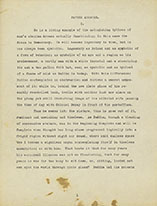 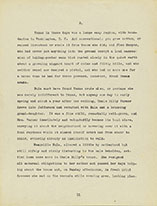  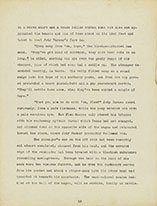 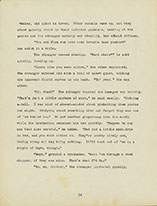 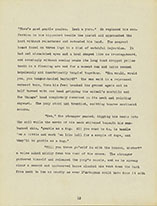 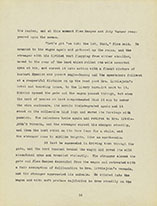 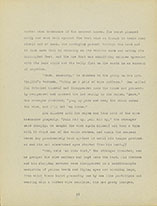 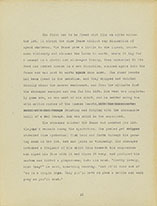 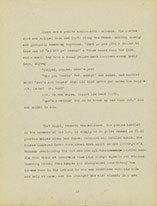 Faulkner didn't resume work on a novel about Flem's rise for a decade. The first volume of what became the Snopes trilogy, The Hamlet, was published in 1940; it takes Flem from a Frenchman's Bend cropper's cabin to a wagon on the road to Jefferson, But in the years after putting "Father Abraham" aside, Faulkner continued to rework the auction episode to sell as a magazine story. Below left: the first page of "As I Lay Dying." In the novel with that title, Jewel Bundren owns one of the calico horses that Flem brought back from Texas, but that's the only connection between these two texts; I confess I don't see how the title "As I Lay Dying" is relevant to the auction story. According to the sequence of texts established in Joseph Blotner's biography, this was Faulkner's first revision. It dramatically recasts the narrative technique of "Father Abraham," re-telling the tale as an almost unpunctuated transcript of a vernacular conversation about Flem and the "arction" - i.e. the auction - set on the porch of Varner's store in the Bend, and it must have been written before October 25, 1929, because by that date Faulkner had decided to use As I Lay Dying as the title for his third Yoknapatawpha novel. As Blotner notes, it's also "curious" that the typescript's pages are numbered 204 to 221; if this version was once part of some larger manuscript, no evidence of it has survived. Center: the first page of his second revision, a 15,000 word tale titled "The Peasants"; its third-person narrative jumps right into the moment of Flem's return from Texas with a "string of calico ponies." Faulkner submitted it in August, 1930, to Scribner's magazine, which rejected it, though with the offer to reconsider it if Faulkner could cut it by about half. Right: Page 1 of the shorter version that Faulkner sent first in January 1931 to The Saturday Evening Post, which paid better - and then, after the Post declined it, back to Scribner's in February. This time the story is told by a first-person narrator who, in a more characteristically Faulknerian fashion, begins after the auction is already in the past. Scribner's bought this version, though asked Faulkner to give it a different title; he suggested "Horses" - "That's all that's necessary" - but by the time it was published in June 1931 it had become "Spotted Horses." 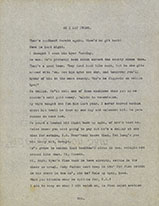   Faulkner revised the story a last time for The Hamlet, where it appears in Book Four, "The Peasants." The essential basis for this final version is the Scribner's text, though in the novel it's again told in the third-person, and considerably longer. After escaping from the corral at Mrs. Littlejohn's, the horses disappear into the landscape of Yoknapatawpha - except for that one Jewel rides. V.K. Ratliff briefly re-tells how "that Texas feller arctioned off them wild Snopes ponies" at the start of The Town, the second volume in the Snopes trilogy (35-36). But more curious, and perhaps more telling, is the echo of the horses you might hear in the episode with which that novel ends. Another surprise arrives in the county from Texas: the four bi-racial children of Byron Snopes and an unnamed Jicarilla Apache. At least as deadly as rattle-snakes, these kids cause even more chaos than the horses, leading me to wonder if the 'spotted-ness' of the horses Flem Snopes brings into the county is significant. There are no mixed race or non-white characters at the auction, but as the "Father Abraham" typescript puts it, the horses themselves are "vari-colored" (page 11 above). It could be that the horses and Byron's offspring are meant to suggest the wildness of the frontier, but the horses may also evoke, as Byron's children explicitly do, the idea of miscegenation: a potentially destructive breaching of the color line that meant so much in Faulkner's South. The countrymen at the auction arrive in wagons pulled by mules; certainly by seeking to own a horse they are (like Flem) pushing against the boundaries of class. But it's possible that, unconsciously at least, for Faulkner the prospect of disorder - equine or social - implies a threat to traditional racial structures as well. SOURCES: Joseph Blotner, William Faulkner: A Biography; Blotner, ed., Selected Letters of William Faulkner. Citing this source: |
